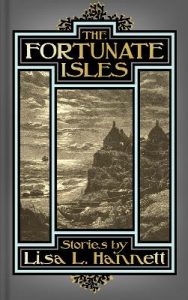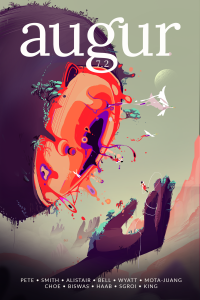Ian Mond Reviews The Fortunate Isles by Lisa L. Hannett
 The Fortunate Isles, Lisa L. Hannett (Egaeus Books 978-1-83839-608-4, £39.00, 250pp, hc) May 2023.
The Fortunate Isles, Lisa L. Hannett (Egaeus Books 978-1-83839-608-4, £39.00, 250pp, hc) May 2023.
Lisa L. Hannett is a “drop everything” author, in as much as I will drop everything to read her latest work. This has been the case since I picked up her debut collection, Bluegrass Symphony, in 2011. That book, with stories set in a fantastical version of America’s prairie lands, established Hannett’s remarkable storytelling skills. 2015’s Lament for the Afterlife, Hannett’s ambitious mosaic novel about an unceasing war, only reinforced my views. With its non-linear, fragmentary structure steeped in imagery and ambiguity, it should have received far more acclaim and notice than it did. It was only as I checked out Hannett’s bibliography that I saw, to some surprise, she had two collections out in 2020. One of them, Songs for Dark Seasons, was released just as COVID captured the globe’s attention. The second, Little Digs, seems to have fallen afoul of its publisher ceasing to exist. Thankfully, none of this has deterred Hannett. This year has already seen the publication of Viking Women: Life and Lore, an academic work that intends to shed light on a group of women (“wives and mothers, girls and slaves, widows and witches”) whose existence has been nearly erased by their male counterparts. Then there’s The Fortunate Isles, a collection of 14 stories (reprints and originals) that, like Bluegrass Symphony, centres on a single community, the fictional harbour town of Barradoon.
The tales in The Fortunate Isles draw mainly on European and Celtic folklore, like selkies, kelpies, harpies, and mermaids. The collection’s opening piece, “Gutted”, has Erl, who doesn’t believe in selkies, go along with the lie – which he cruelly passes onto his children – that his wife has joined her shape shifting sisters. The truth, which we get in snatches before the reveal, is far grimmer. “Gutted” also briefly features mermaids, or more precisely their corpses, fresh caught from the sea, in the hands of the fisherwives who “make short work of the fleet’s catch…. Thigh-length fillets slap into piles on the jetty while bloodless heads, grey shoulders and breasts splash back into the ocean.”
This bloody tableau is not Hannett’s sole depiction of mermaids. It’s a label applied to the women of the village who head out to sea searching for a child of their own. We get a taste of this experience in “The Widows Guild”, while “A Shot of Salt Water” shows that these water babies are not entirely human – a fact that doesn’t always sit well with the boyfriends and husbands left to raise the child. “A Right Pretty Mate” is a coming-of-age story about the young men of Barradoon who marry the harpies hatched from the eggs they find on the cliffs surrounding the village. Like most of Hannett’s fiction, it’s a story that gradually reveals itself, expanding beyond the harpies (awesome though they are) to present us with an ending that’s both subtle and poignant. As for the kelpies, you can discover them for yourselves: their appearance is a surprise I wouldn’t dare spoil.
If there’s a theme that wraps together all of Hannett’s work – including the marvellous stories she wrote with Angela Slatter – it’s that no single voice defines a community. In the case of Barradoon, we see the village mainly through the eyes of the women: the wives, daughters, lovers, healers and sailors. They describe a place where there’s a fine line between empowerment and abuse, where women can sail the seas, working in harmony to deal with raging storms (“The Widows Guild”), but also where they can be slaughtered with impunity by their husbands (“Gutted”) or sexually violated by their brothers (“Rewild”). But even that’s a simplification. It doesn’t convey the raw beauty, unvarnished and fragile, at the core of these tales. I think of the heartrending “Another Mouth” and Maura, who makes a deal with the “young strangers” (Hannett’s chilling take on the fae) to bring her catatonic husband (“not quite drooling”) back to life following the awful death of their child. I think of the extraordinary love story “Out at the Shillingate Isles”, which sees Gert, punished by the powerful Stagg women for being unfaithful to their brother, fall head over heels for a familiar Norse trickster. I think of the horrific and visceral “A Tanglesmithed Tale”, where Bøda, treated with disdain by her drunk beau, Davvy, knits him a sweater infused with magic, anger, and pain that changes the man in ways that Bøda never intended.
Along with a lovely introduction from Kirstyn McDermott, Egaues Press, who craft gorgeous-looking books, have paired Hannett’s evocative and lyrical prose with moody, dramatic illustrations of sailing ships and coastlines by 19th-century Norwegian painter Peder Balke. It’s the cherry on top of what is a magnificent collection.
Ian Mond loves to talk about books. For eight years he co-hosted a book podcast, The Writer and the Critic, with Kirstyn McDermott. Recently he has revived his blog, The Hysterical Hamster, and is again posting mostly vulgar reviews on an eclectic range of literary and genre novels. You can also follow Ian on Twitter (@Mondyboy) or contact him at mondyboy74@gmail.com.
This review and more like it in the July 2023 issue of Locus.
 While you are here, please take a moment to support Locus with a one-time or recurring donation. We rely on reader donations to keep the magazine and site going, and would like to keep the site paywall free, but WE NEED YOUR FINANCIAL SUPPORT to continue quality coverage of the science fiction and fantasy field.
While you are here, please take a moment to support Locus with a one-time or recurring donation. We rely on reader donations to keep the magazine and site going, and would like to keep the site paywall free, but WE NEED YOUR FINANCIAL SUPPORT to continue quality coverage of the science fiction and fantasy field.
©Locus Magazine. Copyrighted material may not be republished without permission of LSFF.







